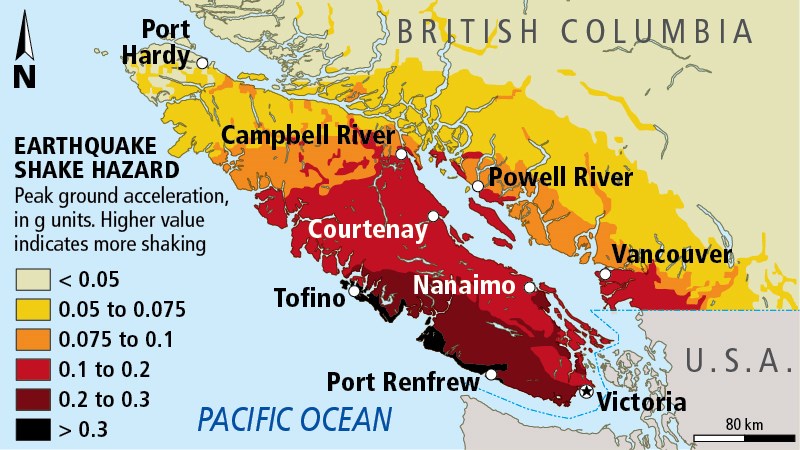Canada is unprepared for a major earthquake that would cause tens of billions of dollars in damage and have a crippling domino effect on the economy, says a new study released Tuesday.
A magnitude 9.0 earthquake in B.C. would cause almost $74.7 billion in damage — $62 billion in property damage and $12.7 billion in indirect economic impact, according to the study released by AIR Worldwide, a catastrophic risk modelling firm.
Only $20.4 billion of those losses are insured.
“Canada faces a major risk for which we are clearly not prepared,” said Don Forgeron, president and CEO of the Insurance Bureau of Canada, which commissioned the study.
The study laid out two scenarios of earthquakes in B.C. and the Ontario-Quebec region to analyze the insurance and economic costs.
Southwestern B.C. falls into a high-risk area, with a 30 per cent chance that a significant earthquake will strike in the next 50 years, according to studies by the Geological Survey of Canada and National Resources Canada.
B.C.’s Cascadia subduction zone, also called the “ring of fire” and located just off the regional coastline, produced a mega-quake in 1700 and seismic experts say it’s just a matter of time before the next Big One.
In the first scenario, a magnitude 9.0 earthquake hits 75 kilometres off the west coast of Vancouver Island, triggering a tsunami, landslides and fires.
The southwest area of Vancouver Island would see the most damage.
Poorly built structures and historic heritage buildings in downtown Victoria and Duncan would crumble.
Victoria would be ravaged by fires and homes in Esquimalt, Gordon Head and Cordova Bay would be destroyed by a tsunami or landslides. Sea ports in Victoria, Port Alberni and Nanaimo would be incapacitated for months. The report did not speculate on a death toll.
Metro Vancouver would also see damage, although not as significant, with moderate damage in Vancouver, New Westminster, Surrey and Delta. Significant damage would be expected in west Richmond, Gilmore and Paramount due to tsunami waves. Bridge damage would limit access to Vancouver International Airport for the first few critical days.
The study does not predict when the next major earthquake could hit, but “the scenarios are very credible,” said Dr. Jay Guin, the AIR Worldwide scientist who led the study.
The federal government announced in its throne speech this month that it intends to work with provinces and territories to develop a national disaster mitigation program. Earthquake drills such as the Great B.C. Shake Out are important tools for reminding people to be prepared, Forgeron said.
According to the study, there have been at least 24 significant earthquakes in the past three centuries that have been widely felt in Canada.
They have been concentrated in two regions: off the B.C. coast and in southern Quebec and southeastern Ontario, two seismic zones that affect 40 per cent of the country’s population.
It’s been more than two decades since there was a comprehensive study of the economic impact of an earthquake in Canada, the authors said, and much has changed since then, including urban development, population growth and advances in earthquake research and building codes.
“[The study] will form the scientific basis for better preparing Canada and Canadians for a major event in the years ahead,” said Gregor Robinson, chief economist for IBC.
The peer-reviewed study was completed over a year and a half by a team of more than 20 scientists, economists, insurance specialists and risk-modelling experts at a cost of more than $1 million.
A 7.7 earthquake shook Haida Gwaii in October 2012, the strongest recorded in Canada since an 8.1 earthquake rocked the same area in 1949. No damage was reported.



